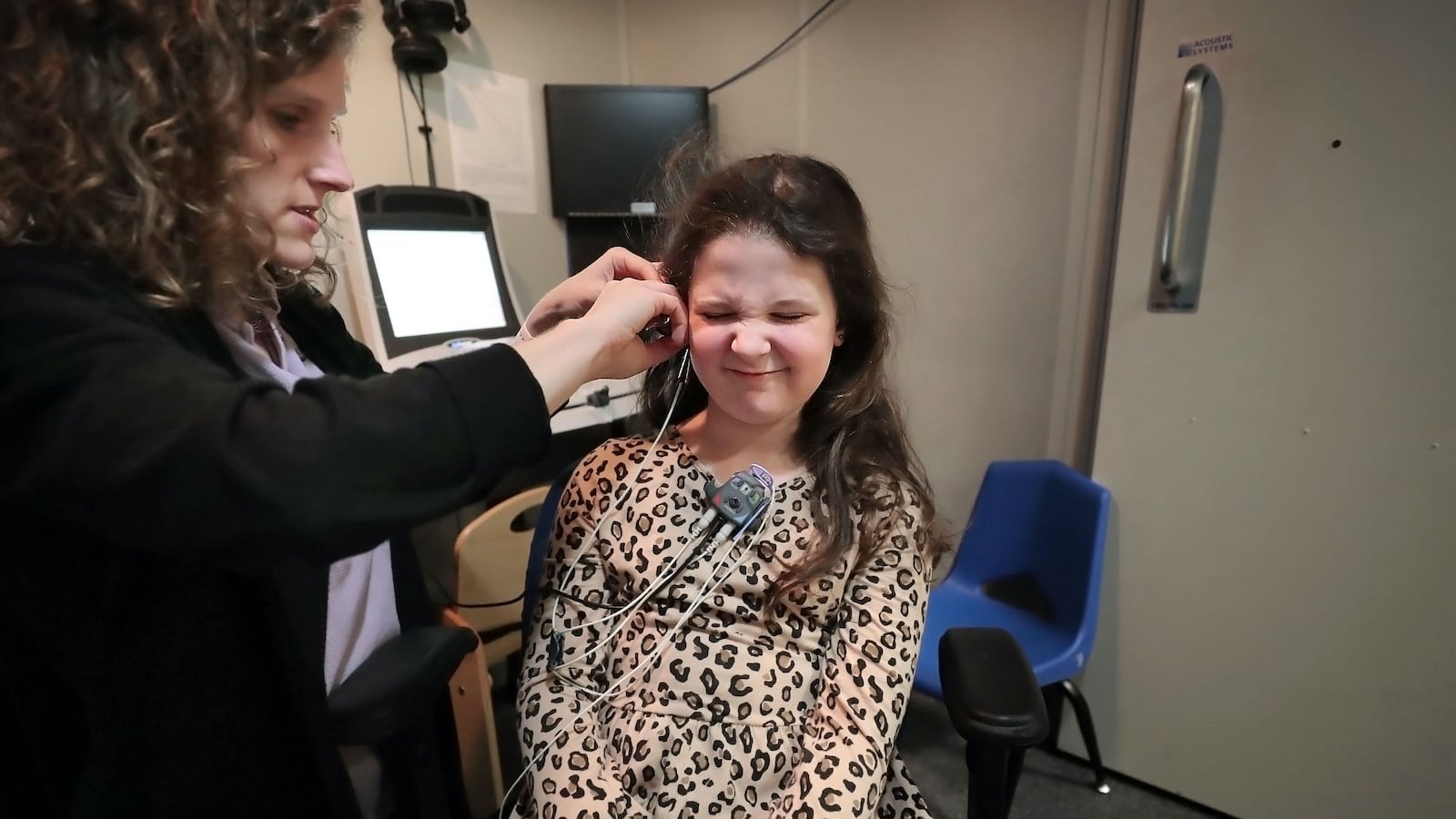Karin Moore has come to rely on Tennessee’s 3-year-old voucher program for students with disabilities. Without it, the former special education teacher said she couldn’t afford to homeschool her 12-year-old twin sons, who have autism.
Then last fall, the disbursements she receives to pay for curriculum and tutoring started showing up late, said Moore, who lives in Bartlett, northeast of Memphis. She had to borrow money in December to cover the costs. The state office she had known as responsive and helpful suddenly took weeks to return calls.
“Everything fell apart,” said Moore, who has limited income and receives disability payments.
Tennessee’s Republican-backed Individualized Education Account program, or IEA, is under increased scrutiny. Democrats and other voucher opponents are seizing on problems in the program — including parents being cited for disallowed purchases — to bolster their case that Tennessee can’t be trusted to launch a second, larger school voucher program this summer on Republican Gov. Bill Lee‘s accelerated timeline.
But Moore’s experience, and that of other parents like her, spotlights another aspect of the existing voucher program that has received little public attention: upheaval and uncertainty in the state Department of Education office charged with overseeing the relatively small initiative.
The resignations of the IEA director and her two staff members, a lag in replacing them, a failure by the state to answer pleas for more resources, and the challenges of overseeing a complicated program have all contributed to delayed disbursements and a frustrating information void in recent months, according to parents and current and former education department employees.
“We used to get great communication including regular newsletters about upcoming deadlines, important links to everything. But now, nothing,” said Cale Horne, one of two parents serving on an IEA advisory council, which was created to give the education department feedback.
Education Commissioner Penny Schwinn, whom Lee appointed to the role just over a year ago, declined to be interviewed for this story. In a written response to questions from Chalkbeat, department spokeswoman Chelsea Crawford called changes in the IEA office an appropriate response to “management issues.”
“The department has prioritized assembling a team that has the knowledge and skill sets needed to lead and execute the IEA program with fidelity,” Crawford said.
Department officials point to plans to improve the existing program and ensure the state’s rollout of the larger voucher effort will succeed.
“We are not ever going to send a message that everyone has been perfect in the past,” said Robert Lundin, assistant education commissioner of school models and programs, who began overseeing the IEA office in October. “What we’re committed to is responsiveness as well as examining every system that’s in place.”
But several parents say the administration’s changes are making the program harder for families to use and they worry their children might become a casualty in a battle over Tennessee’s plan to extend vouchers to other students in school districts in Memphis and Nashville.
Tennessee’s first voucher program
The IEA program was created under a 2015 state law designed to give eligible families more choices if public education isn’t working for them.
That was the case for Moore, the Bartlett parent of twin boys. Her sons struggled in public schools, she said. The money available to families through the voucher program to cover state-approved private educational services — up to $6,600 a year — was not nearly enough for her to afford private school tuition. After enrolling her sons in a virtual school Moore termed a “disaster,” she committed to educating them herself.
“The IEA program is essential for me to be able to homeschool my sons,” she said.
The program started small in the middle of the 2016-17 school year, with 36 families receiving a total of $60,500 in those first months.
The paperwork and record-keeping involved was considerable — and still is. Families receive periodic disbursements through debit-style cards, and parents must submit paperwork every few months to show where the money went. When parents don’t comply, the state removes their students from the program.
Kris Benassi, another Bartlett parent, uses the voucher money to pay for private tutoring, curriculum, and technology to homeschool her hearing-impaired daughter, Gigi. Even as an accountant, she found it challenging to navigate the state’s financial reporting systems.
“I haven’t had a quarter yet where there wasn’t some expense issue that needed to be worked through,” she said recently.

The state ultimately has approved all of her family’s submissions, Benassi said. But the “cumbersome process” takes weeks and sometimes months of back-and-forth communication after the IEA office flags spending as potentially improper. Many expenses like technology and tutors require pre-approval. She regularly has to resubmit receipts from various providers. And she had to appeal the state’s decision once.
The IEA office has faced challenges, too. Tennessee was one of the first states to provide such a program, and there was no successful blueprint to follow. Staff had to make judgment calls on what constitutes allowable expenses. Should electric keyboards get approval for music education? How about gaming devices that help develop fine-motor skills? Making those decisions required thought for each disability, which range from deaf-blindness to orthopedic issues to traumatic brain injury.
The type of vouchers adopted by Tennessee — education savings accounts — can be fertile ground for misspending and poor accounting. Unlike traditional vouchers that pay only for private school tuition and fees, the savings accounts cover an array of expenses from tuition and tutoring to homeschool materials and online learning programs.
And serious problems have emerged in other states’ ESA initiatives. In Arizona’s program for students with disabilities, a state audit found $700,000 in fraudulent and misspent purchases, including cosmetics and clothing, in fiscal year 2018. The disclosures prompted a closer look at similar programs across the country, including Tennessee’s as the legislature approved creating a second larger education savings account program for students in the state’s two largest cities.
Since its launch in January of 2017, Tennessee’s IEA program has had spending and accounting irregularities, but on a small scale. With the first 36 students, the rate of misspending was 5%. The following year, 2% of expenses were ultimately disallowed, even as the program’s enrollment more than doubled, according to state reports.
The state has yet to release statistics for the 2018-19 school year. However, the Associated Press reported last month that the department flagged parents for $30,000 in disallowed expenditures that year, with an undisclosed portion of that amount being overturned through the appeals process.
Lundin, the state official now overseeing the IEA program, estimated that less than 4 percent of the $728,801 in disbursements made to 137 families in 2018-19 will be disallowed by the time that all accounts are reconciled.
Some parents in the program, however, are concerned that the state’s financial oversight of their accounts has weakened this school year. They point to sweeping changes in IEA staffing and experience, as well as communication problems.
“If there’s been any misspending, it’s mostly because the program has been expanded, and nobody in the state’s office is answering the phone or returning emails,” said IEA advisory council member Horne, a Hamilton County father whose son has autism. “Parents haven’t been able to get answers.”
Under Schwinn, the IEA office has been in flux. Last spring, the office was moved from the oversight of Assistant Commissioner Elizabeth Fiveash to Assistant Commissioner Katie Poulous. Both have since resigned, as did IEA Director Rebecca Wright, who left last June and wasn’t replaced.
Wright’s assistant resigned four months later and wasn’t replaced in 2019, and a third employee left Jan. 3 — all part of a staff exodus at the Department of Education under Schwinn. The department has portrayed the turnover, which Chalkbeat found was higher than comparable periods in previous administration, as healthy and normal.
Employee turnover, discontent in education department high under Schwinn
Departing IEA employees have been replaced with one-full-time worker and a temporary hire, while Lundin said he and several other employees with other responsibilities are helping out, too.
Growing pains
Wright, while director, said that monitoring voucher funds was challenging and that the program would need additional resources to handle growth in enrollment.
From the outset, the IEA office had relied on the state’s own limited electronic system for parents to submit paperwork. Staff used spreadsheets to track applications and expenses — a labor-intensive process that opened the program up to human error but also helped the office become familiar with each student’s individualized needs.
Soon after Schwinn’s arrival in February of 2019, Wright presented a proposal to the commissioner asking for $300,000 to build an automated system to manage payments to parents or, as an alternative, to hire an outside company to provide one. According to a copy of her pitch obtained by Chalkbeat, Wright said the new system could help her team consolidate about 30 forms.
“The online system would drastically reduce the amount of time the IEA team spends processing the forms, which would allow the IEA team to respond to parents more quickly, and would reduce program administration costs,” she wrote.

Schwinn did not respond, according to several people who worked at the department during that time and spoke on the condition of anonymity.
Wright also tried unsuccessfully to hire a fourth employee to return her office to the size that was originally funded by the legislature under the 2015 law, according to several former employees. The position, to bolster accounting, was approved prior to Schwinn’s arrival but was abruptly pulled last spring. Wright resigned soon after.
An education department spokeswoman did not answer Chalkbeat’s questions about the proposal for the automated system or IEA staffing decisions.
Schwinn has said she plans to bring more changes to the program, including moving to a more efficient automated system for administering IEAs.
Her spokeswoman said the commissioner plans to migrate the accounts eventually to ClassWallet, the Florida-based vendor that the state hired last fall for $1.25 million a year. The company will manage online payments and applications for Tennessee’s new education savings account program, starting next school year with up to 5,000 students.
Under ClassWallet, families won’t receive disbursements through a state-issued debit card. Instead they will use an electronic platform described as a “virtual wallet,” which moves approved state funds directly from parents’ ClassWallet accounts to the accounts of private education providers.
Deputy Commissioner Amity Schuyler, who is overseeing the transition, said the new system will let the state oversee education savings accounts on a wider scale, while also decreasing the likelihood of fraud.
Parents like Benassi say they support holding families accountable for their spending of taxpayer dollars though education savings accounts. But they also want to know how the state is spending money when the office is not fully staffed, especially since 6% of their voucher amount helps pay for the program’s administration.
They also bristle when Democratic lawmakers characterize their program as “riddled with fraud.”
“It makes us all sound like we’re all trying to defraud the government,” said Benassi, whose 8-year-old daughter, Gigi, is among 164 students currently enrolled. “We are just part of a tiny little program that makes a huge difference in the lives of individual families.”


